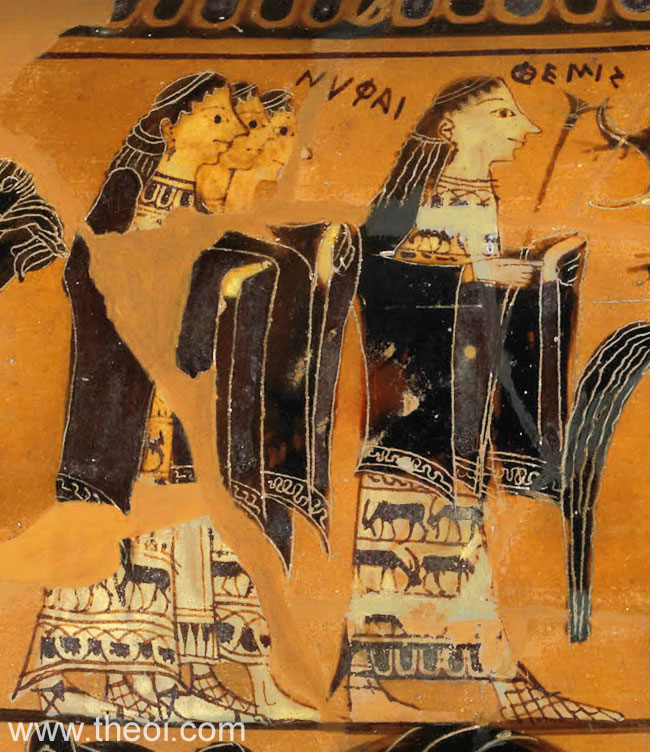NYMPHAI THEMEIDES
Greek Name
Νυμφαι Θεμειδες
Transliteration
Nymphai Themeides
Latin Spelling
Nymphae Themeides
Translation
Daughters of Themis

THE THEMEIDES were three nymph daughters of the goddess Themis who were the keepers of certain artifacts of the gods.
They may have been goddesses of the oracle of Dodona, divine counterparts of the Peleiades--the three elderly prophetesses of the shrine. Their mother Themis certainly possessed a temple in the sanctuary.
The Themeides were perhaps also identified with the Horai (Horae), the Dodonides nymphs of Dodona, the prophetic Thriai (Thriae) of Mount Parnassos, the Nymphai Hesperiai (Hesperian nymphs) of the River Eridanos, and the three Hesperides. Their role and designation as "nymph daughters of Themis" is rather vague.
PARENTS
ZEUS & THEMIS (Apollodorus 2.114)
CLASSICAL LITERATURE QUOTES
Pseudo-Apollodorus, Bibliotheca 2. 38-39 (trans. Aldrich) (Greek mythographer C2nd
A.D.) :
"Perseus said he would return them [i.e. the eye and tooth of Graiai (Graeae) hags] after they had directed
him to the Nymphai (Nymphs). These Nymphai had in their possession winged sandals and the kibisis,
which they say was a knapsack . . . They [the Nymphai] also had the helmet of Haides.
When the daughters of Phorkys [i.e. the Graiai] had led Perseus to the Nymphai, he returned them their tooth and
eye.
Approaching the Nymphai he received what he had come for, and he flung on the kibisis, tied the sandals
on his ankles, and placed the helmet on his head. With the helmet on he could see whomever he cared to look at,
but was invisible to others."
Pseudo-Apollodorus, Bibliotheca 2. 46 :
"[Perseus] gave the sandals, kibisis, and helmet back to Hermes, and the Gorgon's [Medousa's] head
to Athena. Hermes returned the aforementioned articles the the Nymphai (Nymphs)."
Pseudo-Apollodorus, Bibliotheca 2. 114 :
"Herakles continued by foot through the Illyrians' land and hurried on to the Eridanos (Eridanus) river
where he found the Nymphai (Nymphs) who were daughters of Zeus and Themis. They showed him [where to find the
sea-god] Nereus."
Pausanias, Description of Greece 3. 17. 3 (trans. Jones) (Greek travelogue C2nd A.D.)
:
"[In bronze at the temple of Athene in Sparta in Lakonia (Laconia) :] There are also represented Nymphai
(Nymphs) bestowing upon Perseus, who is starting on his enterprise against Medousa (Medusa) in Libya, a cap and
the shoes by which he was carried through the air."
Quintus Smyrnaeus, Fall of Troy 4. 128 ff (trans. Way) (Greek epic C4th A.D.)
:
"[The wedding of Peleus and Thetis :] Singing of Peleus' Bridal of Delight, which all the blest Immortals
brought to pass by Pelion's crests; sang of the ambrosial feast when the swift Horai (Horae, Seasons) brought in
immortal hands meats not of earth, and heaped in golden maunds; sang how the silver tables were set forth in
haste by Themis blithely laughing; sang how breathed Hephaistos (Hephaestus) purest flame of fire; sang how the
Nymphai (Nymphs) in golden chalices mingled ambrosia." [N.B. The nymphs mentioned in this passage are
presumably the three daughters of Themis labelled "nyphai" in the vase painting illustration above.]
SOURCES
GREEK
- Apollodorus, The Library - Greek Mythography C2nd A.D.
- Pausanias, Description of Greece - Greek Travelogue C2nd A.D.
- Quintus Smyrnaeus, Fall of Troy - Greek Epic C4th A.D.
BIBLIOGRAPHY
A complete bibliography of the translations quoted on this page.